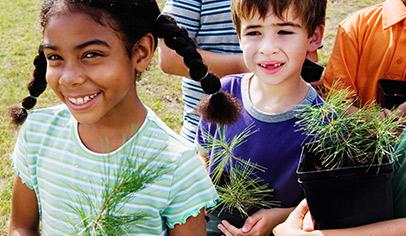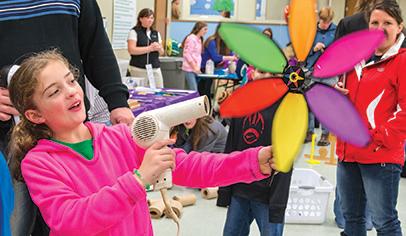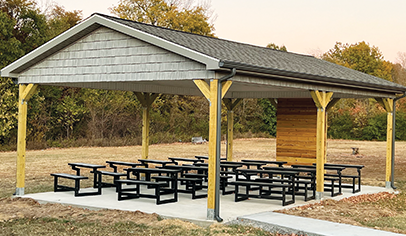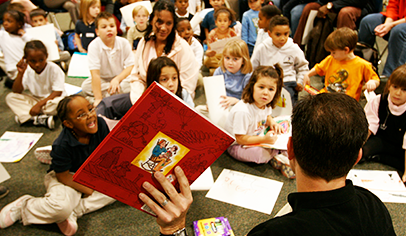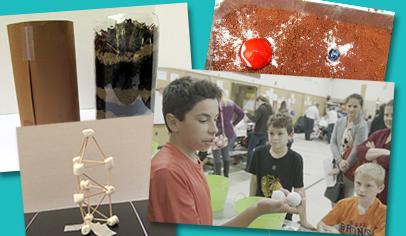When the PTO at Spring Hill Elementary in McLean, Va., sent out a survey about what parents thought the school was doing well—and not so well—one identified area of weakness was science. That wasn’t so surprising, for elementary schools typically focus much more heavily on reading and math than on science. “A teacher’s day is so busy with language arts, math, and social studies that they don’t have time to do science,” says Principal Roger Vanderhye. “And reading about science is not the same as actually doing it.”
Since that survey, the school and its parents have bolstered the science curriculum in ways both creative and passionate. The crowning glory is a new science courtyard, what Vanderhye calls “an actual living laboratory,” complete with a pond, a place for plant experiments, and a gazebo. While some students conduct controlled studies to determine the effects of light, fertilizer, water, pesticides, and vinegar, others simply enjoy the natural surroundings. Local merchants donated materials, supplies, and expertise; parents raised money for the project and devoted hundreds of hours of labor.
Parents in science-related professions also shared their expertise at a science night that drew 150 families to hear them talk about why learning science proved so critical for their careers as a NASA scientist, an environmental scientist, an orthopedic surgeon, a heart surgeon, and a military officer. “We will do that again,” says Vanderhye. “It was really phenomenal.”
Spring Hill also celebrates science with a daily moment of science every morning on its closed-circuit TV show run by students. “Kids bring in stuff,” says Vanderhye. “They find rocks or nests over the weekend. Whatever kids have learned special or discovered on their own, they bring in artifacts to share on TV with everyone else.”
Science is a natural passion at Brandywine Elementary in Greenfield, Ind., where many parents work at nearby Eli Lilly, a leading pharmaceutical company. After one parent approached Principal Bruce Miller about a hands-on science organization he’d read about, the school sent two parents to Maryland for training, and Brandywine’s PTO Hands-On Science Club was born. Parents trained by those two (now the co-coordinators), teach weekly after-school sessions for eight weeks at a time, with different classes for different levels. These sessions are offered in the fall, winter, and spring for $20 per pupil. Students conduct experiments relating to weather, for example, or making different kinds of paper airplanes. It’s similar to what science teachers do but more informal, says Miller.
The science experiments that draw students at Highlands Elementary in Naperville, Ill., are performed on a stage during Family Science Night. The school’s Home and School Association spent $500 to $600 for a free event attended by over 300 people. Scientist Steve Belliveau from Getting Excited About Science showed how much iron exists in cereal by grinding the breakfast food in a blender and putting a magnet on it, surprising the audience with how much cereal stuck to the magnet; he also carried students across the stage in a hovercraft.
“He focuses on broad science concepts but demonstrates them in a way that kids say wow,” says Amy Vander Veen, cochair for School/Family/Community Partnerships, which promoted the event with a huge bulletin board featuring a mad scientist, a tornado, and overflowing beakers. “The first year we did it in December, and you never know, pre-Christmas, what kind of crowd you’ll get,” she says. “All these people coming for a curriculum event blew our minds.” When the school repeated the event, more hands-on activities at science stations followed the show.
A more extensive, more expensive approach to getting students excited about science is the High Touch–High Tech program used by the PTO at Gainfield Elementary in Southbury, Conn.; for an annual cost of over $3,500, a certified teacher guides students through such hands-on science activities as “Dig It,” in which students use hard-boiled eggs to represent the layers of the earth’s crust and also pan for rocks and minerals they can keep.
Some schools are fortunate to receive support from local or national science agencies. Northwestern Elementary in Eaton Rapids, Mich., which had participated in a pilot study in science and math funded by the Capital Area Science and Math Center, created a science/nature center behind the school, complete with interpretative signs at learning stations and a small amphitheater. DeMiguel Elementary, in partnership with Flag Middle School in Flagstaff, Ariz., was one of 50 schools nationwide chosen as a NASA Explorer school, a three-year pilot program that may lead to satellite links with scientists around the world. Howard Elementary in Eugene, Ore., was one of seven schools in its county selected to participate in a Science Outreach program funded by the National Science Foundation. As part of the program’s focus to increase appreciation of physical science, two graduate students serve as science fellows in classrooms for the school year.
But simpler approaches can be effective, too. The PTO at Newfane Elementary in Newfane, Vt., spent a relatively small amount on a one-week science enrichment program that met for two hours a day for five consecutive days over the summer. During Science Week at Manoa Elementary in Havertown, Pa., students compete in a game show featuring science questions. And at South Park Elementary in Vicksburg, Miss., which bills itself as “a math and science theme school,” students learn about live animals by caring for them in the science lab and about meteorology by researching, writing, and announcing daily weather reports over the intercom every morning.
Interested in running your own science event? Our free Family Science Night kit has everything you need to run a great event, including planning tips, invitation flyers, and lots of science experiments!
Originally posted in 2004 and updated regularly. Family Science Night™ is a trademark of School Family Media®.


